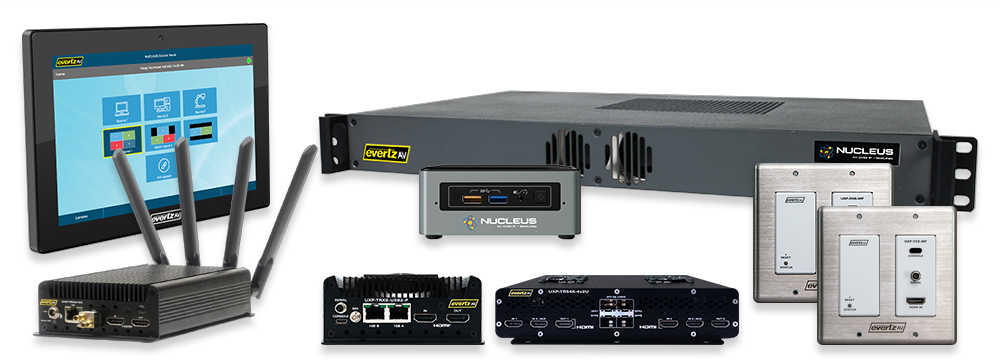Executive Q&A: Under the Radar
EvertzAV VP of engineering, Paulo Francisco, is ready to grow the company's Pro AV presence.

SCN: How long have you been with this company, and what are your responsibilities?
Paulo Francisco: I have been with EvertzAV for just over seven years. I am responsible for the Pro AV side of the business, including product development and service.
[Executive Q&A: Technology Meets Vibe]
SCN: When I think Evertz, I immediately think routers. What features are important in a good router?
PF: Today, Evertz is much more than routers but, yes, we also design and manufacture world-class routers. A good router is purpose built and designed to be non-blocking, resilient, scalable, and fast switching to deliver breathtaking results for mission-critical applications. Whether baseband or IP, our routers/switches are the result of decades of experience in this space.

The other key factor for any router/switch (SDI or IP) is the orchestration and control software. The size and complexity of facilities has grown significantly, thus increasing the need for a comprehensive orchestration, control, monitoring, and analytics software tool. In our case, this is MAGNUM-OS, which manages the largest media facilities in the world, as well our large-scale Pro AV facilities with our MMA10G technology.
SCN: There are plenty of standards out there, so what was the thinking behind EvertzAV’s support of IPMX?
A daily selection of the top stories for AV integrators, resellers and consultants. Sign up below.
PF: IPMX is an emerging open standard for Pro AV, aiming to simplify the landscape, drive multi-vendor interoperability, and make it easier for end users and system integrators to choose solutions for basic AV applications. We embrace and are supportive of this goal.
It is a natural progression for us, given our broadcast leadership and success in the introduction of IP routing and the subsequent introduction and evolution to SMPTE ST 2110. With IPMX sharing many of the same characteristics of SMPTE ST 2110, the transition to IPMX in the Pro AV domain is a very natural fit for EvertzAV.
[Viewpoint: Pioneering the Future of AVoIP]
SCN: What makes the NUCLEUS solution unique in the AV-over-IP space?
PF: NUCLEUS was designed from the ground up to deliver an extensive feature set, large ecosystem of encode/decode endpoints, and ease of deployment, use, and maintenance. It is fully interoperable with standard consumer off the shelf (COTS) managed switches, securely delivering low-latency, pristine video quality over your choice of 1G, 2.5G, or 10G copper or fiber. NUCLEUS was architected to be easily deployed by IT teams using standard practices common to large-scale deployments of technologies such as VoIP and Unified Collaboration (UC).

SCN: We can’t really talk live event production without talking DreamCatcher. How has the platform evolved over the years?
PF: BRAVO Studio is the latest evolution of the DreamCatcher platform. It brings a cost-effective, collaborative, cloud-based suite of tools to handle any kind of live event. BRAVO Studio allows for more stories to be created from anywhere in the world. For the Pro AV space, BRAVO Studio allows Fortune 500 companies, university/colleges, medical institutions, and governments to produce live events that are broadcast quality from anywhere in the world with small teams of varying skillsets. BRAVO Studios brings the highest quality production with lower costs.
SCN: What advice do you have for integrators pitching IP-based production solutions?
PF: Tough question—it really depends on what is being pitched and at what point of the conversation. The path to a happy customer is fully understanding their requirements and not overpromising a technology or solution. So, pitching based on reinforced deployment experience is the path to success.
The path to a happy customer is fully understanding their requirements and not overpromising a technology or solution.
For newer products, have a great working relationship with the vendor and bring them into the discussion to help with the pitch as needed. No one knows the product and technology better than the folks that designed it. EvertzAV provides complimentary Solutions Engineering design services to integrators and provides a full design, with detailed notes, along with the system quote—our goal being to empower our system integrators and consultants with the knowledge and information they need to succeed.
SCN: Evertz acquired Studer back in 2021. How is Evertz celebrating the brand’s 75th anniversary?
PF: The integration of the Studer audio mixing consoles into the Evertz ecosystem has been a success. We’re now developing new Studer products including the Infinity ST Core for IP audio, Vista BRAVO a 12-fader mixing console, plus we're adding Studer controls into VUE for remote production. All these activities honor the Studer tradition of quality and innovation. That is the best way to celebrate 75 years!
[Executive Q&A: Simplified Systems through Standards]
SCN: Evertz is known for a number of different product categories, but in your opinion, what Evertz solution flies under the radar?
PF: EvertzAV is the one that flies under the radar. Evertz is a recognized leader in the broadcast space. In the Pro AV space, we’re considered a smaller player. To address this, Evertz is taking the decades of experience in the broadcast media space and bringing it to the Pro AV market. Today’s Pro AV space is demanding higher quality and resilient solutions and technology as the industry matures. Evertz continues to grow its presence in the Pro AV space by supporting efforts that include IPMX and other proven technologies.
SCN: What new initiatives are we likely to see from your company?
PF: In short, continued innovation and lots of new products, features, and capabilities with a continued commitment to IPMX.

Mark J. Pescatore, Ph.D., has been the content director of Systems Contractor News since 2021. During his career, he's hosted and programmed two ongoing regional industry trade shows (including Future B2B's AV/IT Summit), produced and hosted podcasts and webinars focused on the professional video marketplace, taught more than a dozen college communication courses, co-authored the book Working with HDV, and co-edited two editions of The Guide to Digital Television.
